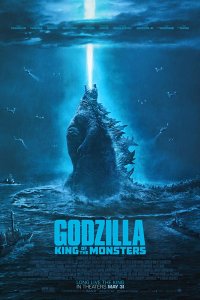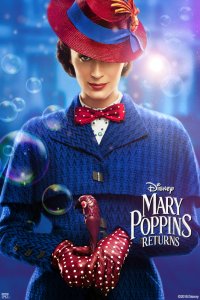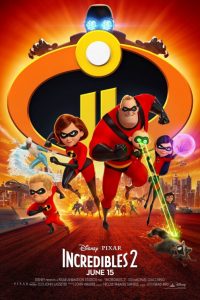Best Monster in a Supporting Role: Gary Westfahl Reviews Godzilla, King of the Monsters
 Michael Dougherty’s Godzilla, King of the Monsters is not the worst Godzilla movie ever made, and when referring to the American films, that constitutes a high compliment; for after watching the first American Godzilla (1998), I personally thought that it was the worst Godzilla movie ever, until I watched the 2014 American Godzilla (review here) and concluded, somewhat controversially, that it was even worse. Nevertheless, any list of the top ten, or top twenty, Godzilla films would still have to list only Japanese productions, since there remain characteristics of a successful Godzilla film that American producers, it seems, simply don’t understand.
Michael Dougherty’s Godzilla, King of the Monsters is not the worst Godzilla movie ever made, and when referring to the American films, that constitutes a high compliment; for after watching the first American Godzilla (1998), I personally thought that it was the worst Godzilla movie ever, until I watched the 2014 American Godzilla (review here) and concluded, somewhat controversially, that it was even worse. Nevertheless, any list of the top ten, or top twenty, Godzilla films would still have to list only Japanese productions, since there remain characteristics of a successful Godzilla film that American producers, it seems, simply don’t understand.
For one thing, monster movies do need to have plots, and they can sometimes get pretty complicated, but the Japanese movies have mastered the art of quickly explaining precisely why the monsters have returned so that the film can properly focus on their destructive antics; in contrast, the American films are always cluttered with back stories. This film begins in the manner of a sequel, as audiences become re-acquainted with Mark Russell (Kyle Chandler), who lost his son when Godzilla attacked San Francisco, his ex-wife Emma Russell (Vera Farmiga), and their troubled teenage daughter Madison (Millie Bobby Brown). The problem is that, actually, none of these characters appeared in the previous movie, demanding overlong introductions. We also have to be given a great deal of information about the mysterious Monarch corporation that for decades has been secretly locating and confining various monsters, prominently including the film’s ostensible stars – Godzilla, the three-headed Ghidorah, the giant pterodactyl Rodan, and the giant moth Mothra – who are each featured in the scene where they escape or are released, usually due to the machinations of “eco-terrorist” Jonah Alan (Frank Dance) and his allies. Because of their recurring presence, though, the first hour of this movie unfortunately requires audiences to spend far too much looking at people with guns fighting with each other, something they have observed in countless films, when they are longing to be looking at monsters.
Further, to account for the appearance of all these hitherto unknown creatures, the film announces that we live on a “hollow Earth” filled with huge underground passages where the monsters have been lurking until an atomic bomb or two stirs them into action. Investigating one passage, our heroes encounter, for no real reason, the sunken continent of Atlantis, still intact after thousands of years, with carvings depicting monsters. It is pointless to complain all of this is implausible – how could this company possibly manage to afford building and maintaining multiple enclosures the size of a small city? didn’t scientists prove centuries ago that the Earth wasn’t hollow? – because all giant monster movies, by their very nature, are implausible. The problem is that all of this expository material becomes tedious.
Yet this is only one aspect of a larger weakness in the American films: in a nutshell, Japan’s Toho Studios makes films about monsters that also include people, while American producers make films about people that also include monsters. Strangely, if the American monsters qualified for Academy Awards, it would be in the category of Best Actor in a Supporting Role. It is true that the Japanese Godzilla films pay minimal attention to dramas involving their human characters, usually budding romances, but the focus is always on the enormous monsters rampaging through cities and battling against each other. The American Godzilla films, in contrast, seem obsessed with the personal traumas of their leading characters, even though these seem trivial in comparison to larger concerns about dinosaurs destroying cities. Let’s face it: when you are watching a battle between Godzilla and Ghidorah, the Three-Headed Monster, the last thing in the world you want to see is a man crying out “I’m stuck!” and the efforts of his comrades to rescue him; yet, during one such battle, the film does cut away from this exciting confrontation to document precisely this contrived drama, and all of the other struggles between monsters are similarly interrupted by scenes depicting imperiled human observers.
One might well ask: if the film’s title celebrates a monster, and all of the surrounding publicity emphasizes its other monsters (listed as performers in the closing credits), why is the film itself so devoted to people and their problems? It all reflects, I believe, an assumption among Hollywood filmmakers that I regard as completely irrational: people only care about other people, so any film that appeals to people must focus on the fates of individual people. Yet, if the genre of science fiction demonstrates anything at all, it is that audiences are willing to sympathize with beings who are not human, or even entire species that are not human. An excellent example is Godzilla himself, now a globally beloved character who even earned MTV’s Lifetime Achievement Award in 1996; and certainly, people will be coming to this film to see Godzilla, not Kyle Chandler or Vera Farmiga.
Thus, if asked to critique this film while it was being made, I would have bluntly told the filmmakers, hey, I don’t give a rat’s ass about whether Russell can reconcile with his ex-wife Emma and find his missing daughter Madison; I am more interested in explorations of the consequences of destructive monsters threatening human civilization and their thrilling encounters with each other. Yet as the film progresses it keeps insisting, amidst all the colorful carnage involving millions of potential casualties, that the only thing that matters, and the only thing that audiences will care about, is whether Russell will be able to rescue his daughter, as it devotes far too much footage to that matter when audiences are instead longing for more attention to the monsters. It might appear refreshing that one character admits that “this is bigger than just you and me” – yet the character given that line is also the one who is primarily responsible for enabling the monsters to reduce all the world’s cities to rubble, rather discrediting the expressed sentiment.
This dogged focus on people, not monsters, also negatively impacts the film’s cinematography: viewers want to see monsters in their entirety, and the Toho films regularly show complete monsters portrayed by people in rubber costumes destroying miniature cities and vying with other monsters. In other words, they display monsters from the perspective of other monsters. However, with its emphasis on human characters, this film keeps displaying monsters as they would be seen by human observers, which means providing only partial or fragmentary glimpses; yet a portion of Godzilla’s face or one of Rodan’s claws is not particularly impressive, although this sadly represents the way that the film’s monsters are usually observed. The occasions when one sees full-sized images of monsters like Mothra or Rodan are impressive and appreciated, yet one wonders why there are so few of them.
Another delightful feature of the Japanese films is that they are unpretentious; true, there are messages in most of them, but they are usually understated, as their creators understand that their audiences are basically interested in watching monsters, and they generally decline to burden their characters with too much ideological baggage. However, as if in response to my previous complaint that the American Godzilla films had no messages at all, the makers of Godzilla, King of the Monsters have foregrounded a few of them, though one of them is laughably risible. Basically, one character explains at great length, people have significantly harmed the environment, which is true enough, but the character’s questionable conclusion is that it is therefore necessary to release an army of ancient monsters to demolish various cities and thus restore the “balance of nature” (though other characters, also at unnecessary length, go on to offer reasonable counterarguments, aptly concluding “You are out of your fucking mind”). When the character said “I’m saving the world by releasing these things,” I was strangely reminded of the ludicrous scene in I Was a Teenage Werewolf (1957) in which mad scientist Whit Bissell explains that the only way for humanity to achieve progress is to turn people into werewolves. The difference is that this film’s character eventually realizes that things are not working out as planned.
Another interesting issue in the film can be viewed as one element in a dialogue of sorts between recent American and Japanese Godzilla films. In a 2005 article, I argued that the Japanese Godzilla 2000 (1999) was in part rebuking Roland Emmerich’s 1998 film, and while reviewing Shin Godzilla (2016 – review here), I noted that it seemed to offer a few criticisms of Gareth Edwards’s 2014 film. In contrast, this film seems to be borrowing a theme from Shin Godzilla: the idea that huge creatures capable of killing vast numbers of humans, instead of being exterminated, should be permitted to survive on the grounds that they represent species otherwise destined to become extinct. Shin Godzilla featured demonstrators demanding that Godzilla be kept alive, and a character asserts that “Mankind must coexist with Gojira.” In this film, while Russell keeps insisting that all of the monsters must be exterminated, scientist Ishiro Serizawa (Ken Watanabe) echoes the position of those demonstrators in maintaining that they must be spared, though his viewpoint is ridiculed as a naive vision of “man and monster living in harmony.”
In the end, however, the decisions made are based on pragmatism, not idealism: Godzilla, along with Mothra and Rodan, will be allowed to live because they have shown themselves to be “good” monsters by defeating the “bad” monster Ghidorah, while it’s perfectly all right to slaughter “bad” monsters. Saving or killing animals based solely on their perceived value to humanity, of course, is precisely the sort of anthropocentric attitude that environmentalists have long fought against, and the argument can also be questioned because, regardless of whether he had an evil intent, Godzilla in the last two films is certainly responsible for more deaths than Ghidorah. And when Godzilla attacks America’s most beloved monster, King Kong, in Godzilla vs. Kong, will he go back to being a “bad” monster?
For long-time devotees of the franchise, Godzilla, King of the Monsters commands attention as the first American film to include some of the other monsters that Godzilla has encountered in numerous Japanese films. I can offer no complaints about the film’s rendering of Ghidorah, but Mothra and Rodan seemed improperly visualized as hostile, even though traditionally (and in this film) they are allies of Godzilla in defending humanity against Ghidorah. I lament the absence of the diminutive singing twins who accompany and support Mothra in the Japanese films, though they would have been difficult to fit into the film’s framework of monsters in Monarch’s cages, since Mothra was traditionally the revered god of natives on a remote island. There are also brief appearances by the forgettable Mutos from the 2014 film and the Japanese giant spider Kumonga, or Spiga, as well as a large creature resembling a woolly mammoth that my son Jeremy (a true expert on Godzilla) does not recall seeing in previous films. One surprising thing is that while the events in this film’s other precursor, Kong: Skull Island (2017 – review here ) are referenced, audiences never see King Kong, even though he will be the co-star of the series’ fourth installment.
Godzilla fans will also be happy that the film’s score incorporates the iconic theme music that has long accompanied Godzilla and Mothra, and a device deployed in the original Godzilla (1954) to kill Godzilla, the “oxygen destroyer,” is brought back for the same purpose, though devotees of the film may be disheartened by its sudden and arbitrary appearance (and needless to say, it again fails to prevent Godzilla’s return). And the film is partially dedicated to the late Yoshimitsu Banno, director of the notorious Godzilla vs. Hedorah, or Godzilla vs. the Smog Monster (1971) and one of this film’s executive producers.
One could applaud these nods to tradition, but the producers also seem indifferent to their own traditions: only three characters from the 2014 film are brought back, and two of them are killed off during this film. Even more oddly, one of those characters is given an extended death scene – so extended, indeed, that it might qualify as the film’s most boring sequence – while the other character’s death occurs offscreen and is only revealed by a message on a computer screen. (Did the performer do something to annoy the director?) Still, adding more and more monsters to movies requires more and more money for special effects, inspiring a desire to spend less on the actors, and none of the performers in these films will ever demand a huge increase in salary to appear in the next film, knowing that producers would probably respond by simply removing their character.
It is finally interesting that all of the American films depart from tradition in one key respect by never situating any of these Japanese monsters in their natural home – Japan. Perhaps producers are simply afraid to do any filming in the country, fearing a negative reaction from citizens who resent the American appropriation of cherished characters who often serve as representatives of their nation. So it is that the previous American films were set in New York City and San Francisco, and this film features escaping monsters originally confined in China, Antarctica, and Mexico, and monsters who destroy Boston and Washington, D.C. One might argue that the Japanese people have already suffered too much due to regular visits from monsters, and it is only fitting that residents of other nations are now suffering as well. But for many, the distinguishing feature of a genuine Godzilla movie will always be a Japanese setting and a Japanese cast.
Directed by Michael Dougherty
Written by Michael Dougherty and Zach Shields, based on a story by Max Borenstein, Michael Dougherty, and Zach Shields, based on characters created by Takehiko Fukunaga, Ishirô Honda, Yoshie Hotta, Shigeru Kayama, Takishi Kimura, Ken Kuronuma, Takeo Murata, Shin’ichirô Nakamura, and Shin’ichi Sekizawa (all uncredited)
Starring Kyle Chandler, Vera Farmiga, Millie Bobby Brown, Ken Watanbae, Ziyi Zhang, Bradley Whitford, Sally Hawkins, Charles Dance, Thomas Middleditch, Aisha Hinds, O’Shea Jackson, Jr., David Strathairn, Anthony Ramos, Elizabeth Ludlow, Jonathan Howard, and the monsters Godzilla, Ghidorah, Mothra, and Rodan, credited as themselves
Gary Westfahl, Professor Emeritus at the University of La Verne, has published 27 books about science fiction and fantasy, including the Hugo Award-nominated Science Fiction Quotations: From the Inner Mind to the Outer Limits (2005), The Spacesuit Film: A History, 1918-1969 (2012), and A Sense-of-Wonderful Century: Explorations of Science Fiction and Fantasy Films (2012); excerpts from these and his other books are available at his World of Westfahl website. He has also published hundreds of articles, reviews, and contributions to reference books. His next two books, to be published in 2019, are the co-edited Science Fiction and the Dismal Science: Essays on Economics in and of the Genre and the critical study The Rise and Fall of American Science Fiction, 1920s to 1960s.
©Locus Magazine. Copyrighted material may not be republished without permission of LSFF.









Correction: Jonah Alan is played by “Charles” Dance, not “Frank” Dance.